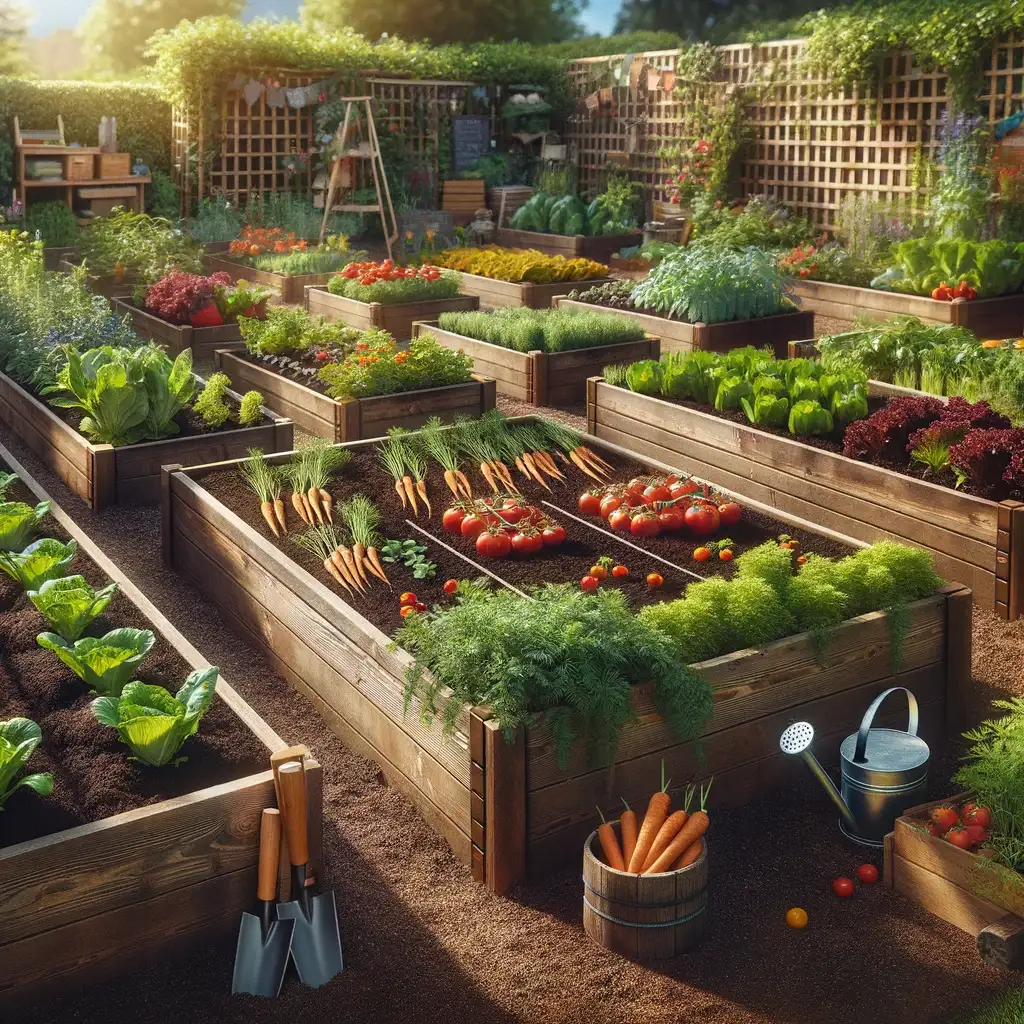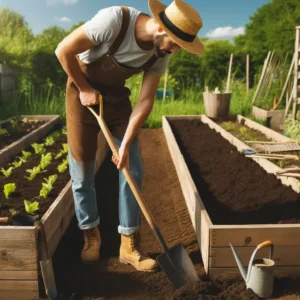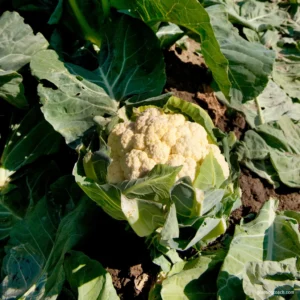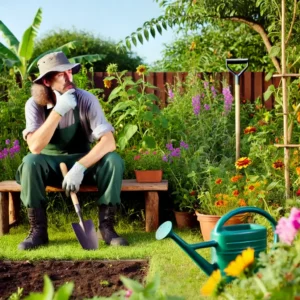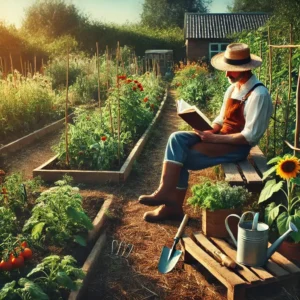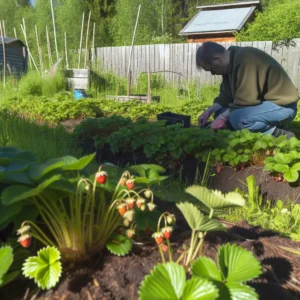Raised bed vegetable gardening has become preferable for many beginners looking to initiate the practice of gardening. This method offers numerous advantages that appeal to those with limited space or unfavorable soil conditions. Raised beds, which consist of elevated soil beds enclosed by a frame, allow gardeners to create an ideal soil environment for their vegetables. Moreover, they ensure better drainage and soil quality and facilitate easier garden management compared to traditional in-ground gardening. So, this guide aims to equip beginners with all the knowledge they need to know about How to Start a Raised Bed Vegetable Garden, from basics to tackling common issues related to it.
One of the main draws of raised bed gardening is its accessibility. The raised nature of these beds means less bending and kneeling, which is particularly beneficial for those with mobility issues. Additionally, the enclosed structure helps to keep pathway weeds from your garden soil and can prevent pests from reaching your plants as quickly as they might in a traditional garden setup. Moreover, the soil in raised beds warms up more rapidly in spring, extending the growing season. As we explore the ins and outs of raised bed vegetable gardening, we’ll cover everything from the initial setup and planning to planting and maintenance.
Understanding Raised Bed Vegetable Gardening
Before diving into the physical labor of building and maintaining a raised bed, it’s crucial to grasp some foundational concepts. Raised bed gardening involves constructing a frame, often made of wood, bricks, or any other durable material, and filling it with a quality soil mix. This type of gardening is beneficial for several reasons. First, it allows you to control the soil environment in which your plants grow. Mixing your soil can ensure it has the perfect balance of nutrients, which can be hard to achieve in native backyard soil.

The advantages of raised bed gardening extend beyond just soil quality. For one, raised beds prevent soil compaction in traditional gardens due to foot traffic, thus ensuring the roots can quickly spread and access nutrients. The raised design also means better drainage, which is crucial for many vegetables and can help prevent root rot and fungal diseases. Furthermore, because the soil is elevated, the sun heats it up faster, extending your growing season. You can start planting earlier in the spring and continue growing later into the fall compared to traditional gardens.
Choosing the right location for your raised bed can dramatically influence your gardening success. Ideally, the bed should be placed in an area that receives at least six to eight hours of sunlight daily, as most vegetables require this amount of sun for optimal growth. It’s also wise to consider the proximity to water sources and whether the area is protected from strong winds, which can damage plants and dry out the soil too quickly. Understanding these basics sets the foundation for a successful raised bed gardening experience, ensuring you maximize your efforts and produce.
Planning Your Raised Bed
The planning stage is critical in raised bed gardening. Determining the size and design of your raised bed will affect everything from what you can plant to how manageable your garden is. Typically, raised beds are about 3 to 4 feet wide, which allows most people to reach the center from either side without stepping into the bed. Length can vary based on your space and needs, but keeping the bed at a manageable size is crucial to avoid soil compaction from walking on it. Regarding height, 6 to 12 inches is standard, but taller beds can benefit those with back problems and accommodate deeper-rooted plants.
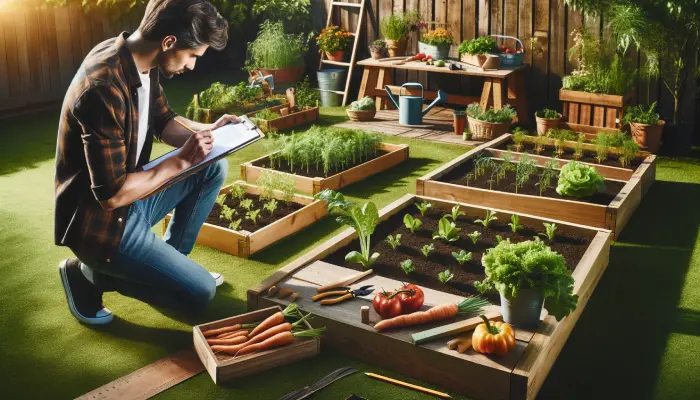
When selecting materials for your raised bed, untreated wood like cedar or redwood is popular due to its resistance to rot and its aesthetic appeal. However, other materials like bricks, concrete blocks, or recycled plastics can also be used. Each material has its benefits and drawbacks in terms of cost, durability, and maintenance, so consider these factors when making your choice.
What to Plant in Your Raised Bed for a Vegetable Garden
When it comes to deciding what to plant in your raised bed, the choices can seem endless. However, for beginners, it’s best to start with vegetables that are known for being more forgiving and easy to grow. Examples include lettuce, radishes, carrots, tomatoes, and bush beans. Each of these vegetables has its own set of evolving requirements, but they generally don’t need as much attention as more delicate or temperamental plants.
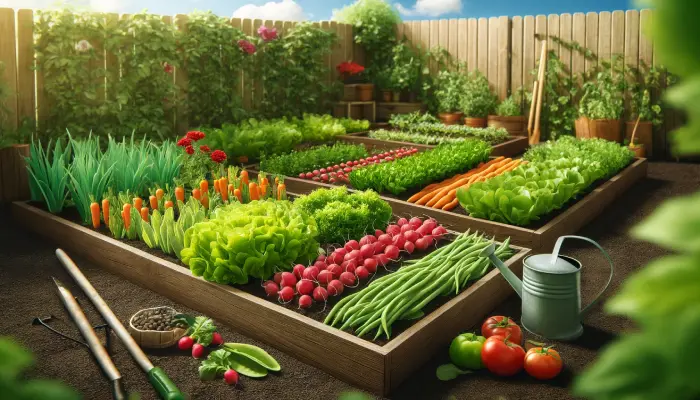
Tomatoes, for example, are a favorite among gardeners due to their usefulness in cooking and the noticeable difference in taste when homegrown. They require a sunny spot and plenty of water once the fruits start forming. Lettuce, on the other hand, grows quickly and can be harvested at almost any stage of growth, making it a rewarding choice for first-timers. Radishes are similarly easy to manage and mature rapidly, providing a satisfying, quick win for new gardeners.
Planting layout is also crucial. Organizing your plants based on their height, nutrient needs, and sunlight requirements can help ensure that each plant has the best conditions possible for growth. For example, planting taller plants like tomatoes at the north end of your bed can prevent them from shading shorter plants like herbs. Companion planting can be beneficial as well; for example, planting marigolds to deter pests naturally or growing basil near tomatoes to develop their growth.
Installing Your Raised Bed
Building your raised bed is an exciting part of the process, where you can start to see your garden take shape. If you choose to create a wooden raised bed, start by selecting rot-resistant wood like cedar. You will need four pieces cut to your desired dimensions and a few wooden stakes to support the corners. Lay out the pieces on a level part of your garden, then secure the corners together using wood screws. Drive the stakes into the ground at each corner, attaching them to the inside of the frame for additional stability.
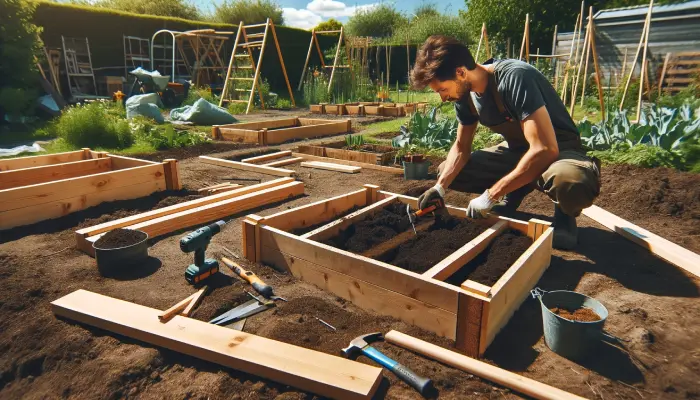
Once your frame is in place, it’s time to fill it with soil. A mixture of topsoil, compost, and potting soil often works well for vegetable gardens as this soil mixture provides a rich, well-draining environment for plants to flourish. Make sure to mix the soils thoroughly for even nutrient distribution. After filling, water the soil to settle it down and add more if necessary to account for any settling that occurs.
Maintaining Your Raised Bed Vegetable Garden
Maintaining a raised bed vegetable garden involves consistent watering, weeding, and monitoring for pests. A key advantage of raised beds is that they dry out faster than ground soil, which can be beneficial during wet seasons but also means you must water them more regularly during dry spells. Installing a drip irrigation system or using soaker hoses can help maintain consistent soil moisture without overwatering.
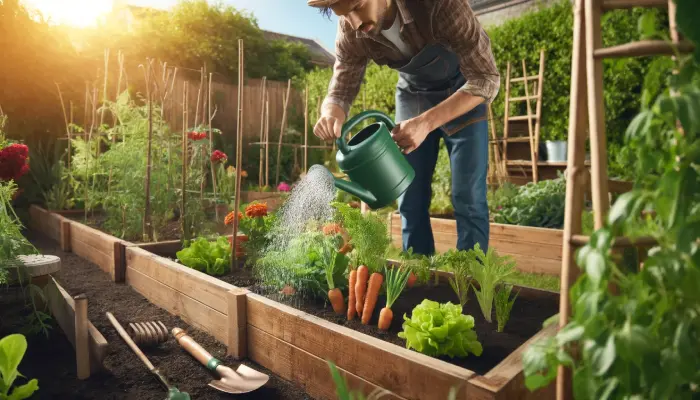
Weeds can be less of a nuisance in raised beds than in traditional gardens, but removing them regularly is vital to prevent them from competing with your vegetables for nutrients. Mulching with straw or wood chips can help suppress weeds and retain soil moisture. For pests, regular inspections are crucial. If you notice signs of insects or disease, identify the problem and use organic solutions like neem oil or insecticidal soap for treatment.
Harvesting from Raised Bed Vegetable Garden
Harvesting your vegetables at the right time is crucial to enjoy the best flavor and texture. Most vegetables are best harvested in the morning with higher sugar content. For leafy greens like lettuce, harvest early, when the leaves are tender and full. Root vegetables like carrots and radishes should be pulled when they are moderately sized to avoid becoming woody.
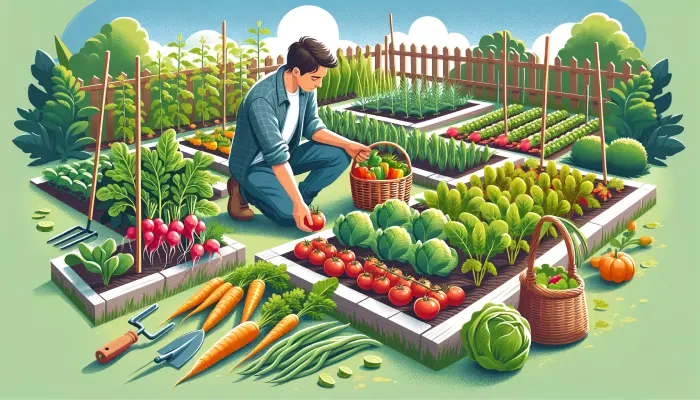
After the primary growing season, it’s essential to manage your raised bed to prepare for the next cycle. Remove any spent plants and refill the soil with compost to restore nutrients. If you live in a region with a mild climate, consider planting a winter crop like kale or garlic. Otherwise, cover your bed with a layer of mulch to protect it during the winter months.
Troubleshooting Common Issues
Even with careful planning and maintenance, problems can arise. Common issues include poor soil drainage, nutrient deficiencies, and pest infestations, which can be real hurdles to starting a raised bed vegetable garden. If your plants are showing signs of stress, such as yellowing leaves or stunted growth, test the soil to ensure it has the proper pH and nutrient levels. Adjustments might include adding more compost or specific minerals.
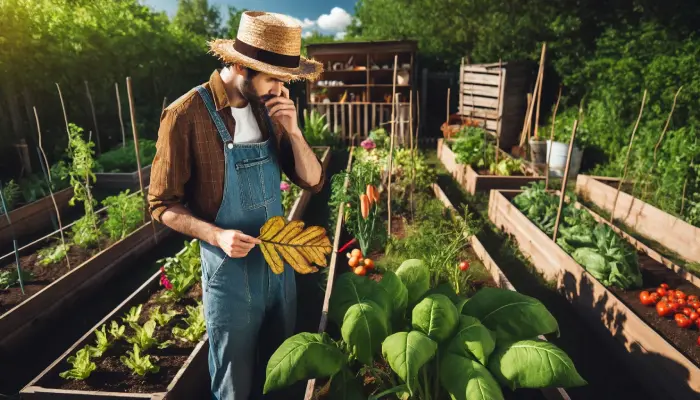
Pests can often be managed with physical barriers like netting or row covers. If diseases strike, remove affected parts immediately to prevent spread and consider crop rotation in the following season to minimize recurring problems.
Expanding Your Raised Bed Garden
As you become more comfortable with the basics of raised bed gardening and start to see the fruits of your labor, you might consider expanding your garden. Adding more raised beds allows you to diversify the types of vegetables you grow and extend your harvest season. Consider incorporating different shapes or sizes to maximize your garden space and sunlight exposure when planning additional beds. For example, narrower beds could be used for herbs and smaller vegetables, while larger ones could accommodate sprawling plants like squash or melons.
Another exciting way to expand is to explore vertical gardening. Vertical structures such as trellises, stakes, or climbing frames can be used within or around your raised beds to grow vining plants like cucumbers, peas, and tomatoes. This saves space and adds an elegant element to your garden. Additionally, vertical growing can help prevent diseases by improving air circulation around the plants.
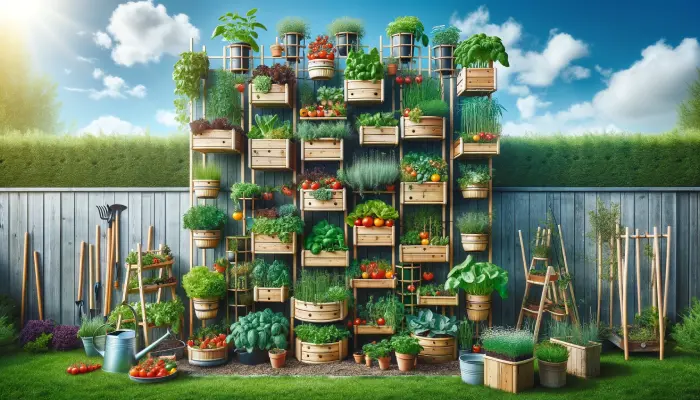
When expanding your garden, it’s also crucial to consider the overall workload. More beds mean more watering, weeding, and harvesting. Be sure that you’re prepared for the additional commitment by possibly integrating more efficient systems, such as drip irrigation or larger composting setups, to handle the increased demand.
Summary
Raised bed vegetable gardening offers a unique blend of convenience, efficiency, and accessibility, making it an ideal choice for beginners. By understanding the basics of setting up and maintaining raised beds, choosing the right plants, and knowing when to harvest, you can enjoy a successful gardening experience that produces fresh, homegrown vegetables. Remember, the key to success lies in careful planning, regular maintenance, and a willingness to learn and adapt through the seasons. Whether you’re a new gardener or looking to transition from traditional methods, raised beds provide a versatile and rewarding gardening approach.
FAQ
Q1: How often should I replace the soil in my raised beds?
- Ideally, you should refresh the soil in your raised beds every few years. This involves adding fresh compost and organic matter to replenish nutrients depleted over time. However, if your plants are still thriving, a full replacement isn’t always necessary. Just top up as needed.
Q2: What are the most cost-effective materials for building a raised bed?
- Untreated pine is one of the most cost-effective materials for building raised beds, but it doesn’t last as long as more durable woods like cedar or redwood. Using recycled materials like old bricks, concrete blocks, or even repurposed pallets can also be an economical and environmentally friendly option.
Q3: Can I use raised beds for growing herbs?
- Absolutely! Raised beds are excellent for herbs. They provide good drainage, which many herbs, especially Mediterranean types like rosemary and thyme, require. You can dedicate a small raised bed to a kitchen herb garden for convenience and easy harvesting.
Q4: How can I make my raised bed garden organic?
- To create an organic raised bed garden, use organic soil and compost, avoid chemical pesticides and fertilizers, and opt for organic seeds or seedlings. Employ natural pest control methods and use mulch to help retain moisture and suppress weeds naturally.
Q5: What is the best way to protect raised beds from frost?
- Cover your raised beds with frost cloths or floating row covers when cold temperatures are forecasted to protect your raised beds from frost. You can also use plastic sheeting for more severe conditions, ensuring it doesn’t touch the plants directly. Mulching heavily around the base of the plants can also provide extra warmth and protection.
